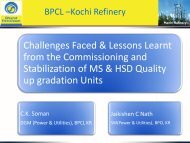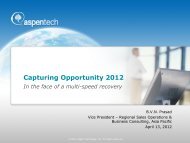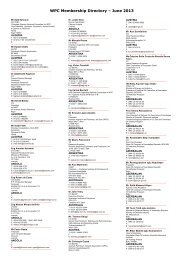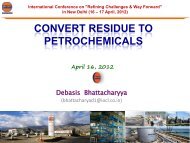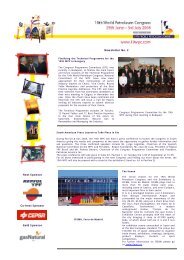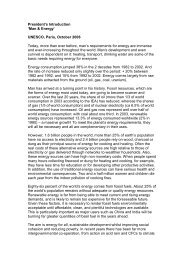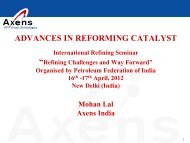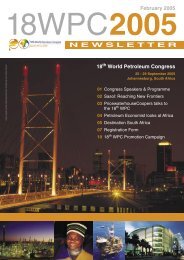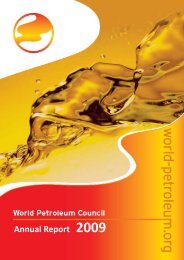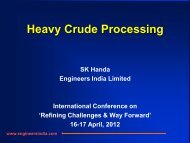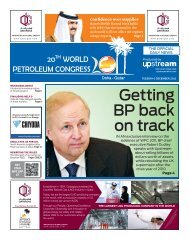pdf here - World Petroleum Council
pdf here - World Petroleum Council
pdf here - World Petroleum Council
You also want an ePaper? Increase the reach of your titles
YUMPU automatically turns print PDFs into web optimized ePapers that Google loves.
Introduction to extraction, refining and processing<br />
Introduction to extraction, refining and processing<br />
Shenhua’s direct coal liquefaction plant, the first of its kind in the world, has been in operation since 2008.<br />
Ongoing research and development efforts are vital to the future of the petrochemicals industry.<br />
and methane. The CO 2<br />
is waste and other gases<br />
can be burnt or processed further.<br />
The second stage for liquefaction is the Fischer-<br />
Tropsch process. Once the coal gas is filtered and<br />
processed, the carbon monoxide and hydrogen<br />
ratio is adjusted by the addition of water or carbon<br />
dioxide. This hot gas is passed over a catalyst,<br />
causing the carbon monoxide and hydrogen to<br />
con dense into long hydrocarbon chains and water.<br />
These chains can be used as an alternative to oil<br />
products such as heating oil, kerosene and gasoline.<br />
The water, meanwhile, can be recycled and<br />
used as steam for the liquefaction process.<br />
Aside from this two-stage process, coal can also<br />
be liquefied via direct coal liquefaction (DCL). This<br />
can take place as a one- or two-stage process. In<br />
the 1960s, single-stage DCL techniques were pioneered<br />
but these first-generation processes have<br />
now been largely superseded or abandoned. The<br />
single-stage processes attempted to convert coal<br />
ded demonstration testing in 2008 and has been<br />
operational ever since.<br />
High-tech challenges<br />
Simply continuing to churn out products we<br />
already know how to make isn’t an option for companies<br />
to remain competitive and profitable. Companies<br />
need to create new products and find cheaper<br />
ways to do things, which is why research and development<br />
is important to petrochemical producers.<br />
The chemical and manufacturing processes in<br />
this part of the downstream business require a<br />
huge pool of expertise – and a lot of money – to<br />
ensure engineers and scientists continue to make<br />
breakthroughs. The drive to produce more with<br />
less, and more cheaply, provides researchers with<br />
access to the sort of facilities rarely found beyond<br />
the commercial sector.<br />
Keeping costs down is vital, because the facilities are<br />
expensive to build, maintain and run. Refiners and petroto<br />
liquids with a single reaction stage, usually<br />
involving an integrated hydrotreating reactor.<br />
In DCL, the coal is put in direct contact with the<br />
cat alyst at very high temperatures (850°F/455°C) in<br />
the presence of additional hydrogen. This reac tion<br />
takes place in the presence of a solvent. The solv ent<br />
facilitates coal extraction. The solubi lised pro ducts,<br />
which consist mainly of aromatic com pounds, then<br />
may be upgraded by conven tional petro leum<br />
refining techniques, such as hydro treating<br />
DCL processes are more efficient than ICL but a<br />
higher quality coal is required for best results.<br />
How ever, since the late 1980s, very few DCl programmes<br />
were continued with the exception of<br />
HTI, now called Headwater Inc, has developed a<br />
two-stage catalytic liquefaction process that was<br />
funded by the US Department of Energy. This technology<br />
was then licensed to China’s Shenhua<br />
Corporation in 2002 for the construction of a<br />
20,000 bpd plant in Inner Mongolia that commen-<br />
chemical producers must also contend with ongoing<br />
volatility in the prices of commodities, with forwardplanning<br />
essential for years when margins are low.<br />
Environmental issues are a vital part of research<br />
in the sector, so firms have to focus on how the industry<br />
can meet increasingly stringent stan dards<br />
for cleaner refining and manu fac turing pro cesses,<br />
and high health and environ men tal standards required<br />
of the final products. These high standards<br />
are often imposed at a self-regulatory level by the<br />
companies themselves and by governments.<br />
In the US, for example, which has more refining<br />
capacity than any other nation on Earth, the sector<br />
is, in the words of the US Department of Energy,<br />
“one of the most heavily regulated industries.” If<br />
refineries fail to comply, they cannot operate.<br />
For alternatives to fossil fuel-based petrochemicals,<br />
see page 102.<br />
William Sripe is a freelance journalist.<br />
28 WPC Guide<br />
Petrochemicals and Refining 29



